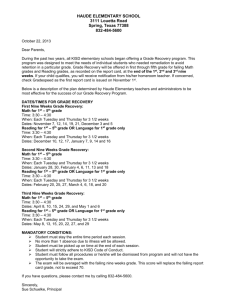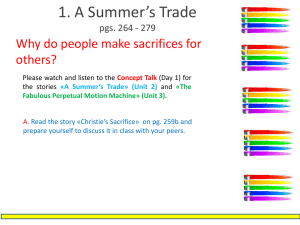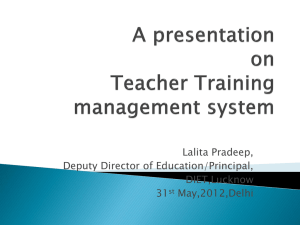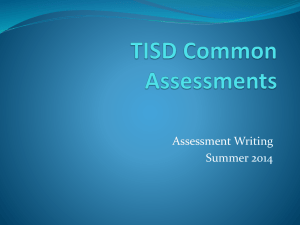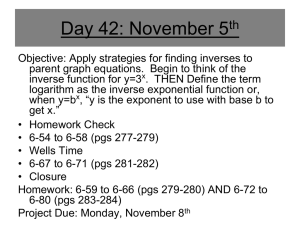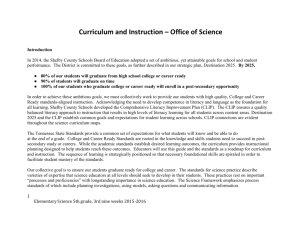Q2 - Shelby County Schools
advertisement
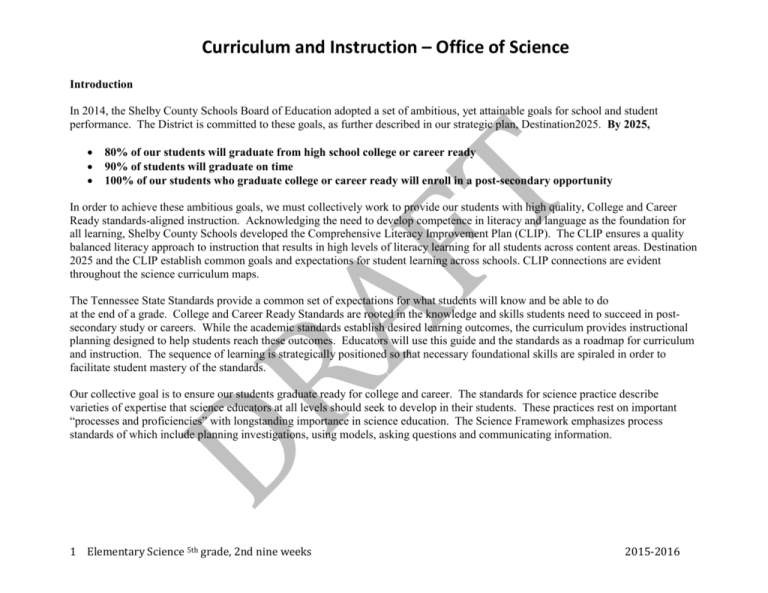
Curriculum and Instruction – Office of Science Introduction In 2014, the Shelby County Schools Board of Education adopted a set of ambitious, yet attainable goals for school and student performance. The District is committed to these goals, as further described in our strategic plan, Destination2025. By 2025, 80% of our students will graduate from high school college or career ready 90% of students will graduate on time 100% of our students who graduate college or career ready will enroll in a post-secondary opportunity In order to achieve these ambitious goals, we must collectively work to provide our students with high quality, College and Career Ready standards-aligned instruction. Acknowledging the need to develop competence in literacy and language as the foundation for all learning, Shelby County Schools developed the Comprehensive Literacy Improvement Plan (CLIP). The CLIP ensures a quality balanced literacy approach to instruction that results in high levels of literacy learning for all students across content areas. Destination 2025 and the CLIP establish common goals and expectations for student learning across schools. CLIP connections are evident throughout the science curriculum maps. The Tennessee State Standards provide a common set of expectations for what students will know and be able to do at the end of a grade. College and Career Ready Standards are rooted in the knowledge and skills students need to succeed in postsecondary study or careers. While the academic standards establish desired learning outcomes, the curriculum provides instructional planning designed to help students reach these outcomes. Educators will use this guide and the standards as a roadmap for curriculum and instruction. The sequence of learning is strategically positioned so that necessary foundational skills are spiraled in order to facilitate student mastery of the standards. Our collective goal is to ensure our students graduate ready for college and career. The standards for science practice describe varieties of expertise that science educators at all levels should seek to develop in their students. These practices rest on important “processes and proficiencies” with longstanding importance in science education. The Science Framework emphasizes process standards of which include planning investigations, using models, asking questions and communicating information. 1 Elementary Science 5th grade, 2nd nine weeks 2015-2016 Curriculum and Instruction – Office of Science Construct explanations and design solution Obtain, evaluate, and communicate information Engage in argument Ask questions and define problems Patterns Develop and use models Practices in Science Use math, technology, and computational thinking Plan and carry out investigations Cause and Effect Stability and change Cross Cutting Concepts Analyze and interpret data Energy and matter Systems and system models Crosscutting concepts have value because they provide students with connections and intellectual tools that are related across the differing areas of disciplinary content and can enrich their application of practices and their understanding of core ideas. Throughout the year, students should continue to develop proficiency with the eight science practices. Crosscutting concepts can help students better understand core ideas in science and engineering. When students encounter new phenomena, whether in a science lab, field trip, or on their own, they need mental tools to help engage in and come to understand the phenomena from a scientific point of view. Familiarity with crosscutting concepts can provide that perspective. A next step might be to simplify the phenomenon by thinking of it as a system and modeling its components and how they interact. In some cases it would be useful to study how energy and matter flow through the system, or to study how structure affects function (or malfunction). These preliminary studies may suggest explanations for the phenomena, which could be checked by predicting patterns that might emerge if the explanation is correct, and matching those predictions with those observed in the real world. 2 Elementary Science 5th grade, 2nd nine weeks 2015-2016 Curriculum and Instruction – Office of Science Science Curriculum Maps This curriculum map is designed to help teachers make effective decisions about what science content to teach so that, our students will reach Destination 2025. To reach our collective student achievement goals, we know that teachers must change their instructional practice in alignment with the three College and Career Ready shifts in instruction for science. To ensure that all student will be taught science content and processes in a comprehensive, consistent, and coherent manner, Science Curriculum Maps are provided. Foundation texts for the maps include Shelby County Schools Framework for Standards Based Curriculum, Science Curriculum Frameworks-K-12 (State of Tennessee Board of Education, and National Science Education Standards). Teachers function most effectively and students learn best within an “aligned” curriculum delivery system. An aligned system begins with a concerted effort to implement the state curriculum frameworks. Many districts have developed curriculum guides built around these frameworks to ensure that what is taught in particular grades and courses is closely linked with student Learning Expectations found in the state standards. Classroom teachers use these locally-generated curriculum guides to plan and implement their individual grade or course Pacing Guides. Expectations for student performance are clear and carefully tied to daily instructional events and classroom assessment practices. In theory, a fully aligned system closes the loop between state standards and student learning. Additionally, a coherent instructional/assessment system offers the potential for heightening student learning as reflected by their performance on state-mandated standardized tests. Our collective goal is to ensure our students graduate ready for college and career. Most of the elements found in the state Curriculum Frameworks were incorporated into the curriculum mapping 3 Elementary Science 5th grade, 2nd nine weeks 2015-2016 Curriculum and Instruction – Office of Science materials prepared by Shelby County Schools. Additional features were included to add clarity and to offer avenues that could assist teacher in developing grade level lessons. A district-wide, K-12, standards-based curriculum is implemented in science. This curriculum is articulated in the form of individual SCS curriculum maps for each grade and subject. These SCS curriculum maps enable the district to implement a single curriculum that emphasizes specific standards. Since Shelby County has a high rate of mobility among the student population, the SCS curriculum maps ensure that all students receive the same program of high-level instructional content and academic expectations, regardless of which school they attend. The utilization of a district-wide standards-based curricular program ensures that students in SCS are engaged in hands-on inquiry based activities as teachers implement the curriculum maps. 1 Elementary Science 5th grade, 2nd nine weeks 2015-2016 Curriculum and Instruction – Office of Science 5th Grade 2nd nine weeks Unit - 5.2.1 Focus - Earth and Space Science Standard - The Universe (Planets & Stars) (Text in blue are hyperlinked to suggested resource) Time Frame - 2 Weeks I Can Statements: ● I can support an argument that the apparent brightness of the sun and stars is due to their relative distances from the Earth. ● I can represent data in graphical displays to reveal patterns of daily changes in length and direction of shadows, day and night, and the seasonal appearance of some stars in the night sky. [Clarification Statement: Examples of patterns could include the position and motion of Earth with respect to the sun and selected stars that are visible only in particular months.] TN Standards 0507.6.1 Compare planets based on their known characteristics. 0507.6.2 Recognize that charts can be used to locate and identify star patterns. Learning Outcomes Distinguish among the planets according to their known characteristics such as appearance, location, composition, and apparent motion. Select information from a complex data representation to draw conclusions about the planets. Identify methods and tools for identifying star patterns. Links To National Standards 2009 NAEP Framework National Science Education Standards: Earth and Space 2 Elementary Science 5th grade, 2nd nine weeks Tasks & Resources MacMillan/McGraw-Hill: A Closer Look Grade 5 Chapter 3: The Universe ● The Inner Planets - Lesson 1: pgs 152-161 ● The Outer Planets - Lesson 2: pgs 162- 171 ● Stars - Lesson 3: pgs 172-185 ● Chapter 3 Review: pgs 186-187 ● TCAP Test Prep: pgs 188-189 Pre and Post Assessment Questions pgs: 38 - 44 CLIP Connection Academic vocabulary Comet, moon, planet, revolution, rotation, star, population, extinct species, endangered species, threatened species, pioneer species, climax community, secondary succession, asteroid, comet, constellation, dwarf planet, Galilean moons, nebula, star chart, solar system, supernova, white dwarf Literacy Connections Labs and Investigations ● How Do Craters Form: pgs 54 - 56 ● How Can We Observe Planets: pg 57 ● Planet Sizes: pg 58 ● Use Numbers: pgs 59 -61 ● How Far Are The Planets: pgs 62-64 ● Observing Constellations: pgs 71-74 ● Stargazing - Students will read the provided informational passage and answer text dependent questions. ● Write an explanatory piece 2015-2016 Curriculum and Instruction – Office of Science Supplemental Assessments ● The Universe Concept Mapping pgs 50 ● Voyager Discoveries pgs 59-60 comparing and contrasting two different planets, using evidence from text(s). Unit II assessment www.scssciencedepartment.weebly.com password: energy Additional Unit 5.2.1 Resource Toolbox Online Resources ● Red Planet - Read, Write, Explore - This website provides literacy activities that focus on the planet Mars. Teachers are provided with teacher instructions, student pages and supplemental readings that can be incorporated into your lessons. Documents are provided in PDF form and only require a download. Resources can also be found in spanish. ● http://www.planetsforkids.org/http://www.planetsforkids.org/ ● https://solarsystem.nasa.gov/kids/ Pink Palace Museum Field Trips ● Sharpe Planetarium: Wonders of the Universe, Astronaut ● Pink Palace Museum Outreach ● Suitcase Exhibits: (free) Planets & the Solar System 3 Elementary Science 5th grade, 2nd nine weeks 2015-2016 Curriculum and Instruction – Office of Science 5th Grade 2nd nine weeks Focus - Earth and Space Science Unit - 5.2.2 - 2 Weeks Standard - The Atmosphere Time Frame ( Text in blue are hyperlinked to suggested resource) I Can Statements: ● Develop a model using an example to describe ways the geosphere, biosphere, hydrosphere, and/or atmosphere interact. [Clarification Statement: Examples could include the influence of the ocean on ecosystems, landform shape, and climate; the influence of the atmosphere on landforms and ecosystems through weather and climate; and the influence of mountain ranges on winds and clouds in the atmosphere. The geosphere, hydrosphere, atmosphere, and biosphere are each a system.] ● Describe and graph the amounts and percentages of water and fresh water in various reservoirs to provide evidence about the distribution of water on Earth. Standards 0507.8.1 Analyze and predict how major landforms and bodies of water affect atmospheric conditions. Learning Outcomes Describe the effects of the oceans on weather and climate. Explain how mountains affect weather and climate Tasks & Resources MacMillan/McGraw-Hill: A Closer Look Grade 5 Chapter 4: Our Dynamic Earth ● The Atmosphere - Lesson 4: pp 230-241 ● Chapter 4 Review: ppgs 242-243 ● TCAP Test Prep: ppgs 244-245 Pre and Post Assessment Questions pgs: 47 - 49 Labs and Investigations ● How Does Distance From an Ocean Affect Temperature pgs 94-96 ● Does A Location of Mountain Range Affect Rainfall? pg 97 ● Climate and Rain Shadow pg 98 CLIP Connection Academic vocabulary atmosphere, weather, climate, current, rain shadow, El Nino. Literacy Connections ● Brazil Today: The Amazon River and Basin - Students will read the informational passage about the Amazon river. Students will answer text dependent questions and describe effects of the destruction of the rain forest using evidence from the text. Links To National 4 Elementary Science 5th grade, 2nd nine weeks 2015-2016 Curriculum and Instruction – Office of Science Standards 2009 NAEP Framework National Science Education Standards: Earth and Space Supplemental Assessments ● Understanding Earthquakes pg 90 Unit II assessment www.scssciencedepartment.weebly.com password: energy ● Write an explanatory piece describing climates in different regions of the world using evidence from text to provide examples of how patterns in climate could be used to predict weather conditions. Additional 5.2.2 Resource Toolbox Online Resources ● http://www.mrphome.net/mrp/rainshadow.swfhttp://www.mrphome.net/mrp/rainshadow.swf ● http://oceanservice.noaa.gov/education/pd/oceans_weather_climate/media/sea_and_land_breeze.swf Pink Palace Museum Field Trips ● Exhibits: Geology, Nature Unleashed (Spring 2016) Nature Unleashed was developed by the Field Museum in Chicago. This link takes you to their website. ● Pink Palace Museum Outreach ● Suitcase Exhibits: (free) Weather 5 Elementary Science 5th grade, 2nd nine weeks 2015-2016 Curriculum and Instruction – Office of Science 5th Grade 2nd nine weeks Focus - Earth and Space Science Unit - 5.2.3 Weeks Standard - The Earth Time Frame - 3 ( Text in blue are hyperlinked to suggested resource) I Can Statements: ● Identify evidence from patterns in rock formations and fossils in rock layers to support an explanation for changes in a landscape over time. [Clarification Statement: Examples of evidence from patterns could include rock layers with marine shell fossils above rock layers with plant fossils and no shells, indicating a change from land to water over time; and, a canyon with different rock layers in the walls and a river in the bottom, indicating that over time a river cut through the rock.] ● Generate and compare multiple solutions to reduce the impacts of natural Earth processes on humans. [Clarification Statement: Examples of solutions could include designing an earthquake resistant building and improving monitoring of volcanic activity.] Standards 0507.7.1 Compare geological events responsible for the earth’s major geological features. Learning Outcomes Tasks & Resources CLIP Connection Describe internal forces such as volcanoes, earthquakes, faulting, and plate movements that are responsible for the earth’s major geological features such as mountains, valleys, etc. MacMillan/McGraw-Hill: A Closer Look Grade 5 Chapter 4: Our Dynamic Earth ● The Plate Tectonics - Lesson 1: ppgs 194-207 ● Volcanoes - Lesson 2: ppgs 208-217 ● Earthquakes - Lesson 3: ppgs 218-229 ● Chapter 4 Review: ppgs 242-243 ● TCAP Test Prep: ppgs 244-245 Academic vocabulary Hydrosphere, plate tectonics, magma, fault, core, mantle, crust, geological features, lava, shield volcano, cinder-cone volcano, island chain, hot spot, island arc, volcano, focus, epicenter, magnitude, tsunami, earthquake, Pre and Post Assessment Questions pgs: pg 45 - 46 Literacy Connections Create a model to illustrate geological events responsible for changes in the earth’s crust. Labs and Investigations ● How Can Mountains Form? pgs 75 - 77 ● Spread Of The Ocean Floor pg 79 6 Elementary Science 5th grade, 2nd nine weeks ● Earth Science Volcanoes - Students will read the informational passage and using details from the text, explain how volcanoes are essential to society. 2015-2016 Curriculum and Instruction – Office of Science ● How Can You Model Different Types of Volcanos pgs 82 - 83 Links To National Standards 2009 NAEP Framework National Science Education Standards: Earth and Space Supplemental Assessments ● Our Dynamic Earth Concept Map - pg 67 ● Pangea and Other Supercontinents Expository Writing - pgs 72 - 73 Unit II assessment www.scssciencedepartment.weebly.com password: energy ● Oh No Volcanoes - Student will read the informational passage and using evidence from the text define the three effects that eruptions and their threat have on humans and cities. ● Our Changing Earth ● What Causes The Earth To Shake? This informational passage can be used as a close read for students to obtain additional information on the effects of earthquakes ● Earth Science: Earthquakes - This article informational passage can be used as a close read for students to obtain additional information on earthquakes as well as it can be used as a focus on author’s purpose. ● Using the articles What Causes The Earth to Shake? and Earth Science: Earthquakes explain how individual communities can use scientific ideas and a scientific understanding of interactions between components of environmental systems to protect a natural resource and the environment in which the resource was found. 7 Elementary Science 5th grade, 2nd nine weeks 2015-2016 Curriculum and Instruction – Office of Science Additional Unit 5.2.3 Resource Toolbox Online Resources ● http://www.bbc.co.uk/science/earth/surface_and_interior/plate_tectonics ● http://www.geocraft.com/WVFossils/collision.html Pink Palace Museum Field Trips ● Exhibits: Geology, Nature Unleashed (Feb 6-May 1, 2016) Nature Unleashed was developed by the Field Museum in Chicago. This link takes you to their website. ● Pink Palace Museum Outreach ● Suitcase Exhibits: (free) Earthquakes 8 Elementary Science 5th grade, 2nd nine weeks 2015-2016 Curriculum and Instruction – Office of Science 5th Grade 2nd nine weeks Unit - 5.2.4 Focus - Life science Standard - Interdependence (The Human Impact) ( Text in blue are hyperlinked to suggested resource) Time Frame - 2 Weeks I Can Statements: ● I can obtain and combine information about ways individual communities use science ideas to protect the Earth’s resources and environment. Standards GLE 0507.2.3 Establish the connections between human activities and natural disasters and their impact on the environment. Learning Outcomes Use information about the impact of human actions or natural disasters on the environment to support a simple hypothesis, make a prediction, or draw a conclusion. Textbook Resources MacMillan/McGraw-Hill: A Closer Look Grade 5 Chapter 1: From Cells To Ecosystems ● Changes in Ecosystems - Lesson 4: ppgs 64-77 ● Chapter 1 Review: ppgs 80-81 ● TCAP Test Prep: ppgs 82-83 Academic vocabulary pollution, extinct species, endangered species, threatened species, primary succession, pioneer species, climax community, secondary successions Pre and Post Assessment Questions pgs: 35 - 37 Literacy Connections Labs and Investigations ● How Do Organisms In A Food Chain Interact? pgs 13 - 15 ● What Are Some Food Chains In A Desert? pg 16 ● Observing Decomposers pg 17 Links To National Standards 2009 NAEP Framework National Science Education Standards: Life Science 9 Elementary Science 5th grade, 2nd nine weeks CLIP Connection Supplemental Assessments ● Relations in Ecosystems (Cloze Activity) pg 9 Unit II assessment www.scssciencedepartment.weebly.com password: ● Pollution In China - Students will read the article and select evidence from the text to support why pollution is a significant cause to mortality in China. ● Super Smog In China - Students will read the article provided and then Describe in your own words how government policy in China worsened the smog problem. Also, how does the Chinese government hold the solution? How might economic and social 2015-2016 Curriculum and Instruction – Office of Science energy pressures in China drive the science on this issue in the future? Be sure to cite evidence from the text in your answer. Additional Unit 5.2.4 Resource Toolbox Online Resources ● http://eschooltoday.com/pollution/air-pollution/what-is-air-pollution.html ● https://www.worldwildlife.org/threats/deforestation Pink Palace Museum Field Trips ● Exhibits: Nature Unleashed (Spring 2016) This exhibit was developed by the Field Museum in Chicago. This link takes you to their website. ● Pink Palace Museum Outreach ● Suitcase Exhibits: (free) Earthquakes 10 Elementary Science 5th grade, 2nd nine weeks 2015-2016
